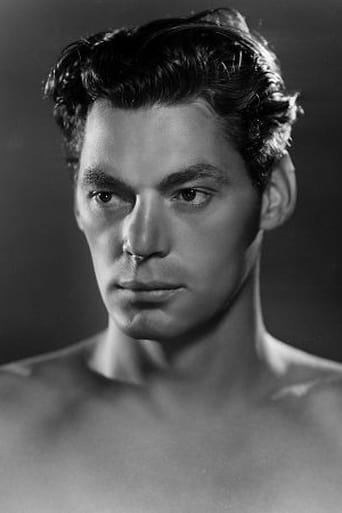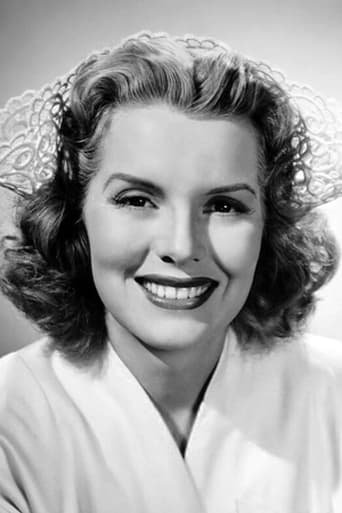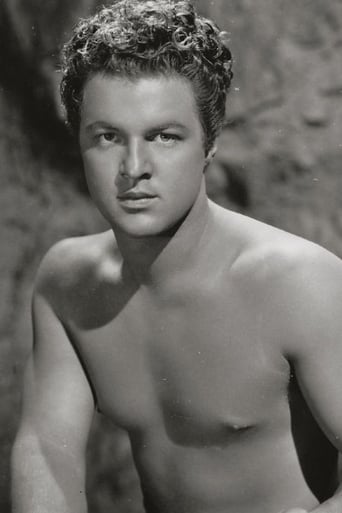Solemplex
To me, this movie is perfection.
Majorthebys
Charming and brutal
Senteur
As somebody who had not heard any of this before, it became a curious phenomenon to sit and watch a film and slowly have the realities begin to click into place.
Myron Clemons
A film of deceptively outspoken contemporary relevance, this is cinema at its most alert, alarming and alive.
flapdoodle64
A lot of fans like to bag on the RKO Tarzan films because they lack the production values of the 6 MGM Weismuller Tarzans (which they do), but a recent channel surfing session gives me an alternative perspective. Specifically, not long ago while eating a sandwich on my couch I found myself watching a section of the first Johnny Weismuller 'Jungle Jim' feature (1948). Seeing Our Hero slogging through Southern California and Stock Footage Africa in a Columbia ultra-cheapie, phoning in his performance and fighting what appeared to be a paper-mache crocodile made by a third-grader, has given me the ability to appreciate the RKO-Tarzans for what they are...solid B-Movie/Saturday Matinnee escapist adventure films.Many intelligent Tarzan scholars disagree on who the greatest film Tarzan was, but none can disagree regarding the cultural impact of Weismuller and no movie Tarzan has ever had a fraction of Weismuller's staying power. Weismuller isn't for everyone, but then again, not everyone likes Elvis. This is the first Weismuller Tarzan film I have seen in about 25 years, and I have to say that after all these years I really enjoyed Weismuller's charisma, confidence and conviction. Weismuller wasn't a good actor per se, but darned if he didn't nail the Tarzan part.Obviously, Weismuller was beginning to have a gut in these later films, but he was still strong and he still carried himself with the pride of an Olympic athlete. If you are a man over age 40, take a good hard look at your own gut some time.RKO apparently didn't have the rights to use the patented bone-chilling hybrid Weismuller/MGMfx Tarzan yell, but as a consolation prize, we get to hear a 100% Weismuller Tarzan yell. The 100% natural yell isn't quite as impressive as the MGM version, but knowing it was 100% Weismuller adds to the enjoyment and novelty.This film has a good plot involving a basically good-natured lady played by the smoking-hot Patricia Morison (clearly upstaging wholesome-sexy Brenda Joyce) who is hunting for zoo animals. Tarzan is ahead of his time in this film, as he opposes taking animals from their native habitat, just as he opposes killing them for anything other than self-defense or sustenance. (In the real world in 1947, keeping animals captive in zoos was universally considered to be humane and ethical.)Cheeta is referred to as a 'she' in this film and has a fetish for putting on make-up. IIRC, in some films Cheeta was a 'he.' Who knows, maybe Cheeta was also ahead of his/her time regarding the idea that one can choose one's own gender identity.Tarzan has one decent hand-to-hand combat fight scene, and while I would have appreciated a little more, the film is filled with appropriate Tarzanic stage business, such as Tarzan stealing all the hunters' firearms while they sleep, and shooting a goose with his bow and arrow. The concluding sequence, where Tarzan initiates an elephant stampede, causing mass carnage and death among the hunters, is well-done and highly satisfying, despite the usage of some stock footage.This film is a fine use of your time if you are a fan of vintage B-features, or a fan of the Weismuller Tarzan. Not his best, but definitely enjoyable and satisfying, with a script and direction much better than your average B-pic.
gerdeen-1
Those unfamiliar with 1940s American slang will miss the clever undertone of the title. Back then, a "huntress" was what women called other women who tried to steal their men. Perhaps to feed a certain misimpression of what the movie was about, a poster of the time shows Patricia Morison's character looking on enviously as Tarzan and Jane enjoy a tender moment. A famous publicity still showed the beautiful Morison clutching her coiled whip. Of course, the promise of hanky-panky and jungle homewrecking was totally false. Morison plays a real huntress, who's after animals. And to tell the truth, except for the visuals, this is one of the duller Tarzan films, short on suspense and exciting action. Morison may look naughty, but she's not a very menacing villain.
Ben Burgraff (cariart)
TARZAN AND THE HUNTRESS suffers from a low budget and a ho-hum plot, although it is far less silly than the previous feature, TARZAN AND THE LEOPARD WOMAN; entrepreneur Tanya Rawlins (Patricia Morison), and her milquetoast lover (John Warburton), mount an expedition to capture animals to restock war-depleted zoos, a not unworthy goal...except they are primarily interested in making big money, which means depleting an area of a large part of it's wild animal population! The local 'lost city' ruler, King Farrod (Charles Trowbridge), showing remarkable farsightedness for the 1940s, limits them to one male and female of each species, which, although showing wise animal management, would not serve the money-hungry Rawlins, at all. Fortunately, she has a ruthless expedition 'boss' (Barton MacLane, making his second 'villainous' appearance in a Tarzan feature), and Farrod has a greedy nephew (Ted Hecht), so a scheme is hatched, to kill Farrod and his heir (Maurice Tauzin), and pay the new King a healthy kickback, in exchange for 'unlimited' hunting (an oft-used scheme of 'bad guys', which would continue to be popular, as recently as George Clooney's SYRIANA).Of course, this being a Tarzan movie, our aging hero is friends with Farrod, and when the ruler is murdered, and the young prince disappears, Tarzan gets involved, which is BAD NEWS for Rawlins and her crew! The film utilizes more 'stock' animal footage than any of the other RKO/Weissmuller features, and unfortunately, it doesn't 'match up' well with the other footage, making the studio scenes look even cheesier; adding to this is a general listlessness in most of the performances, which hurts the overall movie. Even Cheeta seems bored!The most interesting aspect of the film is Johnny Sheffield, who looks startlingly 'adult' in this, his last appearance as 'Boy'. That fact is not lost on screenwriters Jerry Gruskin and Rowland Leigh, who have Tarzan remark, on several occasions, how Boy is becoming "a man". After this feature, Boy would be off to "school in England" (and Sheffield would move on to his own series, as "Bomba, the Jungle Boy").Weissmuller appears tired and a bit out-of-shape, although Brenda Joyce, as Jane, is as fetching as ever! The Tarzan series was obviously "winding down"; the next feature, the surreal TARZAN AND THE MERMAIDS, would mark the end of Weissmuller's reign as "King of the Jungle"...
silverscreen888
By the time "Tarzan and the Huntress" was produced by Sol Lesser with Kurt Neumann, one of my favorite Hollywood talents, the jungle man series was fifteen years old. By saddling the jungle man from the outset with Jane, the MGM executives committed the same error Edgar Rice Burroughs had made in his original creation. There being few excuses to take Tarzan far enough from home to find movie-length adventures, it became necessary to bring those making his actions necessary to him. These included Nazis, strange tribes, but most often unscrupulous hunters of one variety or another. In this unusually-well-directed and attractive entry to the series, the chief of invaders is a far-from-evil but uncaring female, played by gorgeous Patricia Morison. It is this aspect of the film that was copied so often later on; until then, virtually every illicit jungle hunter hand been male, and the only females in the jungle had been lost white goddesses. Fashionable Tanya Rollins is therefore a very important figure in film history. Her hired guide, Barton MacLane, is the real villain of this piece. As a champion of the wild heritage against a flawed pseudo-Christian civilization, Tarzan refuses to let anyone trap animals on his side of the river (never identified). On the other side of the river, the expedition's leaders have struck a bargain with a prince, son of the king (Charles Trowbridge). The bargain is broken, when MacLane has the prince killed, in order to deal with his more amenable brother. Instead of taking two of every animal, the expedition can then take unlimited animals to captivity for remunerative sale. When Tarzan learns that Cheetah has been captured and smells out what is going on, he decides to intervene, at great risk because the bad guys have rifles. This is champion swimmer Johnny Weissmuller's eleventh turn as the King of the Jungle; he is still stolid and sometimes impressive, especially when he has Brenda Joyce as a blonde Jane or raven-haired Morison to play off. And Johnny Sheffield as Tarzan's adopted son, Boy, has become by then an attractive and grown-up young man, on the verge of his own series as the sourceless but likable "Bomba" the Jungle Boy. Others appearing in the cast include John Warburton as Carl Morley, Wallace Scott as Smithers, and Mickey Simpson as Monak. And Cheetah the chimpanzee is given a very large role in the film, almost as an agent of Nature allegorically playing the nemesis to Ms. Rollins' nefarious hopes. The fact that Morison never wanted her men to kill Tarzan, or anyone else, excuses her complicity in what they do to gain unearned wealth; there are exciting scenes as Tarzan bedevils, is nearly killed by and then finally overcomes the true villains. But the highlight of the film, as anyone not suffering myopic of the value-system, should be able to know is the loveliness and performance by Patricia Morison. She has several scenes in a ten;t and when she undresses as a silhouetted figure lighted by a lamp within, or when she argues with Tarzan, or when she visits his home and is bedeviled by Cheetah who steals her lipstick and other implements, she steals the film completely. Like brilliant and vivacious Greer Garson before her, she seems to be beloved by U.S. moviegoers only if they are educated to ignore her British accent; compared for instance to brassy and passable actress Susan Hayward who came along at the same time, she is a gem, classically trained and brilliant either at acting or underplaying, as here. This is a often-imitated film, a milestone of adventure-level fun and adroit characterization; it is very popular with fans, thanks to brilliant director Kurt Neumann, who also co-produced. The authors get lots of fun out of an only-passable story line in every scene; Bbt to this film we owe "Tarzan the Magnificent", "Tarzan and the Lost Safari", "Jivaro" and a number of other films that finally saw a female in a jungle as something other than a danger or a distraction. The music by talented Paul Sawtell and the luminous cinematography by Archie Stout are rich assets here, by my lights. Art direction by McClure Capps and the costumes, especially Ms. Morison's by Harold Clandenning, add to the film's values. The script by Jerry Gruskin and Rowland Leigh is serviceable and some of the dialogue I find to be above-average. Wallace Scott and Ted Hecht were also featured; look for a well-done elephant stampede and Ms. Morison; they are for me the highlights of a seminal and enjoyable exotic-locale adventure.





